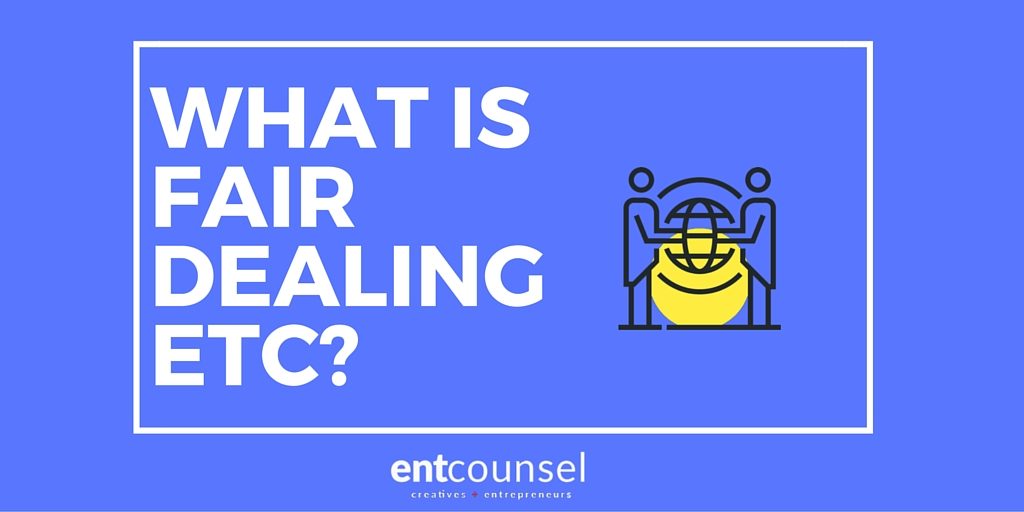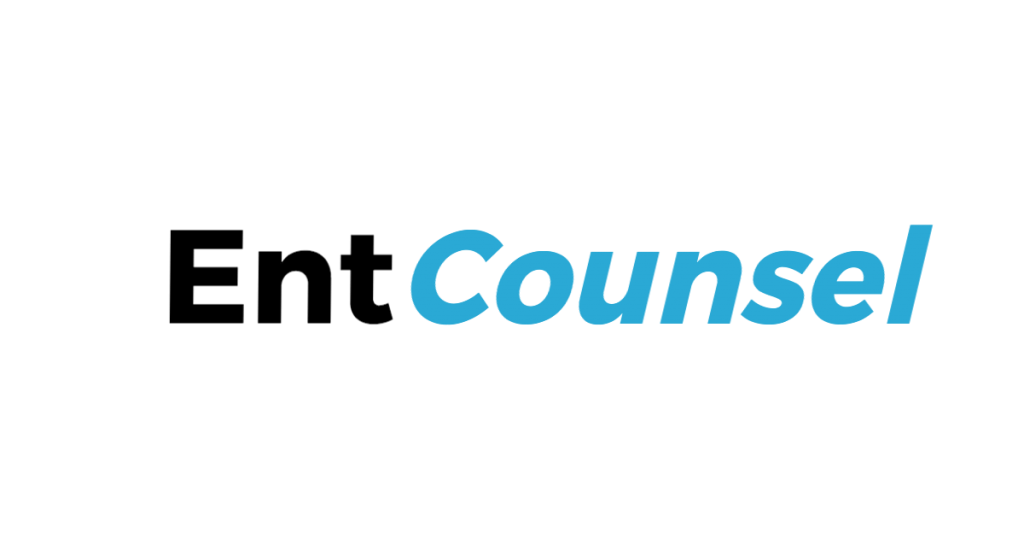Fair Dealing in Canada & Freedom of Expression in Copyright
Fair Dealing in Canada: the Copyright Act
In a copyright infringement action, sections 29, 29,1 and 29.2 of the Copyright Act provides for the use of fair dealing as a defence. There are two basic prerequisites to determine whether someone can use fair dealing in Canada as a defence to a claim of copyright infringement. First, the dealing must be fair. Second, the dealing must be for one the purposes specified in the Copyright Act (private study, research, criticism, review, or news reporting, education and parody/satire) as per the test in the SCC CCH case. However, two SCC decisions after that in 2012, SOCAN and CCLA, further defined the fair dealing analysis.
The fair dealing defence to copyright infringement has expanded over the years. This article will the definition of Fair Dealing and compare it to the US concept of Fair Use. Entcounsel handles a lot of copyright matters and the first thing we look at is whether there is first a fair dealing defence to the infringement before pursuing it.
What is Fair Dealing?
In a copyright infringement action, sections 29, 29,1 and 29.2 of the Act provides for the use of fair dealing as a defence. There are two basic prerequisites to determine whether someone can use “fair dealing” as a defence to a claim of copyright infringement. First, the dealing must be fair. Second, the dealing must be for on the purposes specified in the Act. Fair dealing for one one of the enumerated purposes including:
- research, private study, education, parody or satire;
- criticism or review (Fair dealing for the purpose of criticism, review or news reporting must contain a credit to the source and the author)
- news reporting
- educational institutions
- libraries, archives and museums
- single reproduction of computer programs as backup
- incidental use
- ephemeral recording
- pre-recorded works
- for persons with disabilities
- for purposes of certain federal Acts such as the Access to Information Act
- for the author to make certain copies
- for agriculture fairs
- for religious purposes
- non-commercial user-generated content
- certain reproduction for private purposes
- fixing signals and recording programs for later listening or viewing
- backup copies (of works other than software)
- interoperability of computer programs
- encryption research
- computer systems and network security, and
- temporary reproductions for technological processes
- etc….
However, fair dealing is not an easy defence to prove. It depends on the facts and is analyzed on a case by case basis. It depends on various factors such as the nature of the work copied, the amount and significance of the work copied, the use made of the copy, and the degree to which the copy competes in the market for the original, the availability of a licence from a collective society.
As we know, fair dealing for the purpose of private study and research does not include multiple copying of works by educational institutions to distribute to students in classrooms or cover the selling of course packs.
The Canadian concept of fair dealing is different than the US concept of fair use. Fair use is broader. However, even with the US concept being broader, the court in Texaco still found that the copying was not fair dealing.
In the Texaco case (American Geophysical Union et. al. v. Texaco) which went to the Court of Appeal and settled before U.S. Supreme Court by Texaco agreeing to pay a seven figure amount to the CCC for photocopying licensing. The Court held that it was not fair use under the U.S. Copyright Act for a profit-seeking company to make unauthorized photocopies of copyrighted articles published in scientific and technical journals for use by the company’s scientists employed in scientific research. It is very likely that should Canadian courts be faced with a fair dealing question in the context of photocopying for research for commercial purposes, it would be concluded in much the same manner as the Texaco decision.
In order for fair dealing to be used as a defence, the copying must be for one of the specified purposes (research, private study, criticism, review or news reporting) and the defence only generally only applies to the individual doing the research or private study (i.e. the purpose for which the copying is undertaken is the purpose of the person making the copies and not the purpose of the person for whom the copies are made). *subject to the new exception
The Supreme Court of Canada in CCH Canadian Ltd. v. Law Society of Upper Canada concludes that these exemptions are not “loopholes” and that there must be a balance between “users’ rights” in the free dissemination of knowledge and information and authors and copyrights owners.
Copyright Owner Rights vs. Users Rights
The Supreme Court of Canada has interpreted copyright law as a balance between copyright right owners and users. In the Théberge v Galerie d”Art due Petit Champlain Inc, 2002 SCC 34, [2002] 2 SCR 336 [Théberge], the court stated:
[t]he Copyright Act is usually presented as a balance between promoting the public interest in the encouragement and dissemination of works of the arts and intellect and obtaining a just reward for the creator.
The proper balance … lies not only in recognizing the creator’s rights but in giving due weight to their limited nature. [paras 30-31].
In CCH Canadian Law v Law Society of Upper Canada, 2004 SCC 13, [2004] 1 SCR 339 [CCH], the court notes that fair dealing under the Copyright Act as one of the user rights:
The fair dealing exception, like other exceptions in the Copyright Act, is a user’s right. In order to maintain the proper balance between the rights of a copyright owner and users’ interest, it must not be interpreted restrictively. [at para 48].
The Court in SOCAN (noted below) noted the public interest underlying Copyright law as balancing protection and access and using the concept of fair dealing to help make that determination. CCH described users rights as “ensuring that users’ rights are not unduly constrained”. [para 51]. CCH did not refer to it as “access”.
The Court in SOCAN also noted that “dissemination … with or without creativity, is in the public interest” [para 21] meaning that users rights are not dependent on new copyright works and takes precedence over rewarding creativity. It is my view that this is a dangerous approach and certainly harmful to creators. Copyright must balance the rights of creators and users but not at the stake of not giving freedom to users over rewarding creators for their creativity.
Fair Dealing for the Purpose of Criticism, Review or News Reporting
Fair dealing for the purpose of criticism, review or news reporting must contain a credit to the source and the author pursuant to the CCH factors.
Accordingly, the fair dealing defences of research or private study, criticism or review and news reporting were to be constructed broadly with the Court in CCH noting that:
“Research” must be given a large and liberal interpretation in order to ensure that users’ rights are not unduly constrained” [ para 51].
Fair Dealing for the Purpose of Private Study and Research
- As we know, fair dealing for the purpose of private study and research does not include multiple copying of works by educational institutions to distribute to students in classrooms or cover the selling of course packs.
Fair Dealing for the Purpose of Education and Parody or Satire
Section 29 of the Copyright Act has been amended to include “education” and “parody or satire” in addition to research and private study.
It is interesting that Parliament did not amend the Copyright Act to limit the application of the CCH decision and the fair dealing test and permitted the CCH interpretation of fair dealing as being more broad with users and left it with the courts.
Factors to be Considered For the Fair Dealing Defence
Fair dealing in Canada is not an easy defence to prove. It depends on the facts and is analyzed on a case by case basis. It depends on various factors such as the nature of the work copied, the amount and significance of the work copied, the use made of the copy, and the degree to which the copy competes in the market for the original, the availability of a licence from a collective society.
The Court in CCH outlined the non-exhaustive factors to assess whether the copying constitutes fair dealings such as:
- the purpose of the dealing
- the character and amount of the dealing
- whether there were alternatives to the dealing
- the nature of the work
- the effect that the dealing had on the work
On July 12, 2012, the Supreme Court of Canada decided on five copyright decisions simultaneously which impacted the fair dealing analysis. These include:
- Entertainment Software Association v Society of Composers, Authors and Music Publishers of Canada, 2012 SCC 34, [2012] 2 SCR 231 [Entertainment Software];
- Rogers Communications Inc v Society of Composers, Authors and Music Publishers of Canada, 2012 SCC 35, [2012] 2 SCR 283 [Rogers];
- Society of Composers, Authors and Music Publishers of Canada v Bell Canada, 2012 SCC 36, [2012] 2 SCR 326 [SOCAN]
- Alberta (Education) v Canadian Copyright Licensing Agency (Access Copyright), 2012 SCC 37, [2012] 2 SCR 345 [CCLA]
- Re: Sound v Motion Picture Theatre Associations of Canada, 2012 SCC 38, [2012] 2 SCR 376 [Re: Sound]
The more recent decisions of SOCAN and CCLA enforce the court’s interpretation of fair dealing and user rights.
In SOCAN, the issue was whether a short preview of music prior to purchase are subject to a copyright tariff. The Court unanimously held that the previews constituted fair dealing for the purpose of research.
In CCLA, the Court had to decide whether teachers making copies of short excerpts of copyright works for students was fair dealing for private study or research. The majority of the Court held is as fair dealing while four justices dissented. Both decisions, SOCAN and CCLA endorsed the CCH analysis and factors for the fair dealing analysis {para 39].
The SOCAN decision outlined a two-step test for fair dealing and further defined the scope and court’s approach to fair dealing. The two steps are:
1) The courts must first determine whether the dealing falls within a legislated category
2) Assessment of the fairness of the dealing
This approach was similar to the one taken in CCH. However, the SOCAN decision defined the approach as a legal test and identified the threshold for each step of the test as follows :
In mandating a generous interpretation of the fair dealing purposes. the Court in CCH created a relatively low threshold for the first step so that the analytical heaving-hitting is done in determining whether the dealing was fair” [para 27].
The SCC has noted that certain activities would not be considered fair. These include:
- reproducing books in their entirety fo ran entire class even if for “research or private study” or for “education”.
- downloading music previews versus streaming them would not be fair
Read more about fair dealing HERE.
Fair Dealing in Canada vs. Fair Use in the US
The Canadian concept of fair dealing in Canada is different than the US concept of fair use. Fair use is broader. However, even with the US concept being broader, the court in Texaco still found that the copying was not fair dealing.
In the Texaco case (American Geophysical Union et. al. v. Texaco) which went to the Court of Appeal and settled before U.S. Supreme Court by Texaco agreeing to pay a seven-figure amount to the CCC for photocopying licensing. The Court held that it was not fair use under the U.S. Copyright Act for a profit-seeking company to make unauthorized photocopies of copyrighted articles published in scientific and technical journals for use by the company’s scientists employed in scientific research.
It is very likely that should Canadian courts be faced with a fair dealing question in the context of photocopying for research for commercial purposes, it would be concluded in much the same manner as the Texaco decision.
In order for fair dealing in Canada to be used as a defence, the copying must be for one of the specified purposes (research, private study, criticism, review or news reporting, education or parody/satire) and the defence only generally only applies to the individual doing the research or private study (i.e. the purpose for which the copying is undertaken is the purpose of the person making the copies and not the purpose of the person for whom the copies are made).
This approach is different to the one taken in the US where a particular use does not have to fit within a statutory enumerated purpose or use and that the analysis has to be around the question of fairness. The range of user uses and purposes is not confined within a statutory definition but open ended and decided on a case by case basis.
Freedom of Expression and Copyright Infringement
- Freedom of Expression has been used as a defence to copyright infringement. The Supreme Court of Canada has stated that the Copyright Act permits parties to express themselves using copyrighted works. The SCC used statutory interpretation to protect freedom of expression in relation to copyright. The SCC has stated that statutory provisions may only be interpreted in accordance with Charter values such as freedom of expression in limited circumstances (Bell ExpresVu Limited Partnership v R, 2002 SCC 42 at paras 28 – 30, [2002] 2 SCR 559 [Bell Expressvu]. The Copyright Act permits the restraint of copyright-protected works for expression.
- It has been argued that the provisions of the Copyright Act restraining freedom of expression in using copyright-protected works to express oneself is a restriction on the freedom of expression. In other words, case law argues that a copyright protected work cannot exclude an individual’s right to freedom of expression through the use of a copyrighted work such as wearing a t-shirt with a logo, sending links to movies or songs etc.
- The Supreme Court of Canada has held that both language and artistic expression are protectable forms of freedom of expression. In Reference re s. 193 and 195.1(1)(C) of the Criminal Code, [1990] 1 SCR 1123, 56 CCC (3d) 65 [Reference re: s. 193]. Justice Lamer wrote:
In my view the choice of the language through which one communicates is central to one’s freedom of expression. The choice of language is more than a utilitarian decision; language is, indeed, an expression of one’s culture and often of one’s sense of dignity and self-worth. Langauge, shortly put, both content and form.
In Reference re s. 193 at 1182, the Court also notes that using copyright-protected content like language and art is “an expression of cultural identity, and in many cases is an expression of one’s identity.”.
The Court has also noted in Ford v Quebec, [1988] 2 SCR 712 at para 40, 54 DLR (4th) 577 that:
[l]anguage is so intimately related to the form and content of expression that there cannot be true freedom .. of expression by means of language if one is prohibited from using the language of one’s choice. Langauge is not merely a mean or medium of expression; it colours the content and meaning of expression”.
The use of copyright works and content similar to language and art “colours the content and meaning of expression” as noted in the Ford Case, supra note 43 at 748.
Canadian Broadcasting Corp v. Canada (Attorney General), 2011 SCC 2 at para. 3, 52-53, [2011] 1 SCR 19 [CBC] notes that where the method of expression cannot be separated from the content, the expression is entitled to protection under section 2(b) of the Charter even if the method might “undermine[] the values underlying s. 2(b)” and the use of copyright content “cannot be considered separately from the content and cannot serve as a basis for excluding the expressive activity from the protection of s. 2(b) of the Charter.” (note 40 at para 53) .
Therefore, the use of copyright protected work in any form are instances of individuals expressing their identity and personal expression.
© Entcounsel. Vandana Taxali, 2018.



